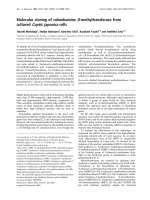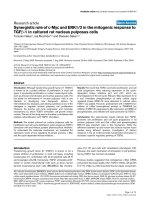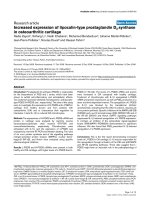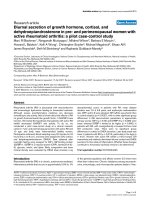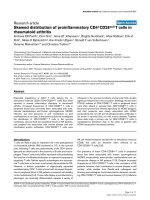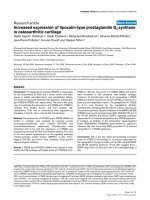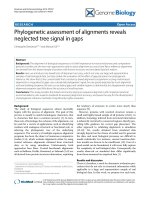Báo cáo y học: " Phylogenetic analyses of the polyprotein coding sequences of serotype O foot-and-mouth disease viruses in East Africa: evidence for interserotypic recombination" pps
Bạn đang xem bản rút gọn của tài liệu. Xem và tải ngay bản đầy đủ của tài liệu tại đây (2.67 MB, 9 trang )
RESEARC H Open Access
Phylogenetic analyses of the polyprotein coding
sequences of serotype O foot-and-mouth disease
viruses in East Africa: evidence for interserotypic
recombination
Sheila N Balinda
1*
, Hans R Siegismund
2
, Vincent B Muwanika
1
, Abraham K Sangula
1,5
, Charles Masembe
1
,
Chrisostom Ayebazibwe
4
, Preben Normann
3
, Graham J Belsham
3
Abstract
Background: Foot-and-mouth disease (FMD) is endemic in East Africa with the majority of the reported outbreaks
attributed to serotype O virus. In this study, phylogenetic analyses of the polyprotein coding region of serotype O
FMD viruses from Kenya and Uganda has been undertaken to infer evolutionary relationships and processes
responsible for the generation and maintenance of diversity within this serotype. FMD virus RNA was obtained
from six samples following virus isolation in cell culture and in one case by direct extraction from an
oropharyngeal sample. Following RT-PCR, the single long open reading frame, encoding the polyprotein, was
sequenced.
Results: Phylogenetic comparisons of the VP1 coding region showed that the recent East African viruses belong to
one lineage within the EA-2 topotype while an older Kenyan strain, K/52/1992 is a representative of the topotype
EA-1. Evolutionary relationships between the coding regions for the leader protease (L), the capsid region and
almost the entire coding region are monophyletic except for the K/52/1992 which is distinct. Furthermore,
phylogenetic relationships for the P2 and P3 regions suggest that the K/52/1992 is a probable recombinant
between serotypes A and O. A bootscan analysis of K/52/1992 with East African FMD serotype A viruses (A21/KEN/
1964 and A23/KEN/1965) and sero type O viral isolate (K/117/1999) revealed that the P2 region is probably derived
from a serotype A strain while the P3 region appears to be a mosaic derived from both serotypes A and O.
Conclusions: Sequences of the VP1 coding region from recent serotype O FMDVs from Kenya and Uganda are all
representatives of a specific East African lineage (topotype EA-2), a probable indication that hardly any FMD
introductions of this serotype hav e occurred from outside the region in the recent past. Furthermore, evidence for
interserotypic recombination, within the non-structural protein coding regions, between FMDVs of serotypes A and
O has been obtained. In addition to characterization using the VP1 coding region, analyses involving the non-
structural protein coding regions should be performed in order to identify evolutionary processes shaping FMD
viral populations.
Background
Foot-and-mouth disease virus (FMDV) is a member of
the Picornaviridae family, belonging to the genus
Aphthovirus [1] a nd is the causative agent of foot-and-
mouth disease (FMD), a highly contagious infection of
cloven-hoofed domestic animals and over 70 wildlife
species [2]. The viral genome is a positive-sense single
stranded RNA (about 8.3 kb, see Figure 1), encoding a
polyprotein which is processed to yield structural and
non-structural proteins [1]. The RNA genome under-
goes a high rate of mutation due to error prone replica-
tion by the RNA polymerase resulting in high genetic
diversity[3],however,notall coding regions evolve at
the same rate [4]. The structural protein coding region,
* Correspondence:
1
Makerere University, Institute of Environment and Natural Resources P.O. Box
7298, Kampala, Uganda
Full list of author information is available at the end of the article
Balinda et al. Virology Journal 2010, 7:199
/>© 2010 Balinda et al; licensee BioMed Central L td. This is an Open Access a rticle distributed under the terms of the Creative Commons
Attribution License ( which permits unrestricted use, distribution, and reproductio n in
any medium, provided the original work is properly cited.
particularly the sequence for VP1, has been shown to
vary significantly between strains and serotypes hence
it is used extensively for evolutionary relationship
inference [5]. Persistent infection, recombination, and
quasi-species dynamics have also been suggested as con-
tributing to the genetic variation [6-8]. Globally, the
virus exists in seven distinct serotypes; the Southern
African territories [SAT] types 1-3 and Eurasian types
namely O, A, C and Asia 1. Immunity to one serotype
does not confer protection against another. In Africa,
FMD is endemic in the sub-Saharan region with six of
the known serotypes recorded in the Eastern African
region [9]. Of the numerous outbreaks reported in this
region, most are attributed to serotype O, followed by
A, SAT 2 and SAT 1 but some cases of serotype C have
been reported in Ethiopia, Kenya and Uganda [9]. SAT
3 has been isolated in 1970 and 1997 from African buf-
falo in the Queen Elizabeth National Park (Uganda) but
has otherwise not been recorded elsewhere in East
Africa [9,10]. Previous studies, based on VP1 coding
sequences, have shown that four different lineages (EA
1-4) of type O FMDV are present in this region[11].
This complex intra-serotypic variatio n coupled with the
presence of multiple serotypes has complicated disease
control, which is achieved mainly by vaccination and
restrictions on animal/animal product movement. In
East Africa, most molecular studies have sought to iden-
tify phylogenetic relationships among viruses relying on
the sequence of the VP1 coding region [12]. Although
used extensively for phylogenetic studies, the VP1
sequence alone may be inadequ ate for revealing all pro-
cesses shaping diversity and evolution of the viruses in
the region [13-15].
Elsewhere on the African continent, remarkable pro-
gress in FMD molecular e pidemiology has been made
particularly in Southern Africa, a region also character-
ized by SAT type endemicity. Molecular epidemiological
studies have been able to reveal the origin and routes of
FMD transmission in this region. In addition, the impor-
tant epidemiological role of the African buffalo (Syn-
cerus caffer) in maintenance of this virus and
transmission to other cloven-hoofed animals has been
highlighted [16-18].
In this st udy, we have analyzed th e polyprotein coding
sequence (6719 nt) of serotype O FMD viruses to get
insights into relationships among these viruses to infer
processes shaping their diversity in the East African
region. Sequences analyzed in this study include isolates
from Kenya and Uganda obtained between the years 1992
and 2006 and sequences already in the Genbank database.
Materials and methods
Viral isolates
The viruses investigated in this study were collected
during outbreaks in the indicated years in Kenya (K)
and Uganda (U). Four samples; O/K/52/1992, O/K/117/
1999, O/K/109/2000 and O/K/48/2005 were from
Kiambu, Nakuru, Uasin Gishu and Kiambu districts,
respectively. FMDV RNA was extracted from these sam-
ples following virus propagation in baby hamster kidney
(BHK) cells. The O/U/25/2006 (Mpigi district) sequence
was generated from RNA prepared directly from an oro-
pharyngeal sample while the O/U/312/2006 virus was
isolated from an orophyrangeal sample from Mbarara
district and grown in primary bovine t hyroid (BTY)
cells.
RNA extraction, cDNA synthesis, PCR and
Cycle sequencing
RNA was extracted from virus harvests and directly
from orophyrangeal fluid using the QIAamp® Viral RNA
kit (Qiagen, Hilden, Germany) according to the manu-
facturer’s instructions. The cDNA synthesis was carried
out using Ready-To-Go™ You-Prime First - Strand
Beads (GE Healthcare Life Sciences, Sweden) with ran-
dom hexamer primers (pdN
6
).
Figure 1 Genomic structure of FMDV. Genome organization of FMD viruses modified from [1]. The 5’u ntranslated region (ca. 1300 nt.),
polyprotein region (ca. 7000 nt.) and the 3’untranslated region (ca 90 nt.) are shown. P1-2A, P2 and P3 indicate the precursors or intermediates
for the capsid region proteins, 2BC proteins and the 3ABCD proteins, respectively.
Balinda et al. Virology Journal 2010, 7:199
/>Page 2 of 9
PCR reactions of overlapping fragments were per-
formed in a final volume of 50 μlusing2-5ngof
cDNA, 0.2 pmol of primers (Table 1) and 2.5 U of
AmpliTaq gold DNA polymerase (Applied Biosystems),
200 μM of each dNTP (dATP, dCTP, dGTP, dTTP) and
1.5 mM MgCl
2
. Following the activation of AmpliTaq
gold DNA polymerase at 95°C for 5 min, reaction mix-
tures were denatured at 95°C for 15 s followed by 60°C
for 2 min to allow for primer anneal ing. For each cycle,
a chain elongation step at 72°C for 1 min 20 s was
allowed. This process was repeated 30 times and final
extension continued at 72°C for 5 min. The resultant
PCR products were analysed using 2% agarose gel elec-
trophoresis with a molecular weight marker (FX174-RF
DNA, Amersham Biosciences). Purification of the PCR
products to remove oligonucleotides, dNTPs and
enzyme was achieved with a QIAquick® PCR purification
kit (Qiagen, Hilden, Germany). Sequencing was per-
formed in both directions using a Big dye Terminator V
3.1 kit (Applied Biosystems) and ran on an automated
DNA Sequencer (ABI PRISM® 3700) by Macrogen,
Korea, using the same primers as employed in the PCRs
Sequence Analysis
Sequencher software 4. 8 (Gene Code Corporation) was
used to assemble the 12 overlapping fragment sequences
generated per sample. Multiple alignments by log-expec-
tation comparison were carried out using MUSCLE [19]
incorporated within Geneious 4.7.6 software [20]. Phylo-
genetic analyses involving the determination of models
of evolution were performed using hierarchical likeli-
hood-ratio test of 24 models using PAUP*(v. 4.0 beta
10)[21]andMrModeltest(v2.2)[22].TheGTR+I+G
model was used and Bayesian inference analysis per-
formed using MrBayes (v.3.1.2) [23] with the following
settings: maximum likelihood model was six substitution
types (nst = 6), with base frequencies set to variabl e
values ("statefreqpr = dirichlet(1,1,1,1” ). Rate variation
across sites with a proportion of invariable sites was
modeled using a g amma distribution (rates =
invgamma). The Markov Chain Monte Carlo search was
run with 4 chains for 500,000 generations with trees
sampled every 100 generations; the first 1250 were dis-
carded as burnin [23]. Recombination between
sequences was analysed using SimPlot method 2.5 soft-
ware [24].
Results
Sequence Characteristics and Phylogenetic Relationships
Almost the entire polyprotein coding sequence (6719 nt)
of five FMDV isolates and a single Ugandan FMDV
RNA sample were determined. Four of these samples
Table 1 Summary of primers used
Primer ID Primers Fragment/Primer combination
8-A PN 2 GTCNCCTATTCAGGCNTAGAAG Fragment 1: 8-A PN-35 & 8-A PN-2
8-A PN 3 GGCTAAGGATGCCCTTCA
8-A PN 4 AACCAGTCNTTCTTNTGNGTG Fragment 2: 8-A PN 3 & 8-A PN-4
8-A PN 6 CCNGTNNACATGAANTGCAGGTT
8-A PN 14 ATCTCNAACTCAAACACTCTG Fragment 3: 8-A PN 34 & 8-A PN-83
8-A PN 22 AAGGACCCNGTCCTTGTGGC
8-A PN 23 CCGTCNAAGTGGTCAGGGTC Fragment 4: 8-A PN 51 & 8-A PN-6
8-A PN 34 ATGGACACNCAGCTTGGTGAC
8-A PN 35 GAGAAANGGGACGTCNGCGC Fragment 5: 8-A PN 84 & 8-A PN-85
8-A PN 45 GGAAGAAACTCGAGGCGAC
8-A PN 46 TGGTCGTTTGCCTCCGTGG Fragment 6: 8-A PN 98 & 8-A PN-64
8-A PN 51 CCACAGATCAAGGTGTATGC
8-A PN 64 GGTTGGACTCCACATCTCC Fragment 7: 8-A PN 86 & 8-A PN-45
8-A PN 68 GGGTCCTTCAGCTGGTGG
8-A PN 80 GGAGTGTTTGGCACTGCC Fragment 8: 8-A PN 22 & 8-A PN-23
8-A PN 83 CTTTGGAAGGGAACTCACC
8-A PN 84 TACTACACCCAGTACAGCG Fragment 9: 8-A PN 46 & 8-A PN-87
8-A PN 85 TGCAGCTTCGGGTGCTCC
8-A PN 86 GGCCATCCACCCGAGTG Fragment 10: 8-A PN 99 & 8-A PN-68
8-A PN 87 CTCAAAGAATTCAATTGCTGC
8-A PN 98 GCATCCACTTACTACTTTGC Fragment 11: 8-A PN 113 & 8-A PN-14
8-A PN 99 TGTACCANCTTGTTNANGAGGTG
8-A PN 101 CAGGGTTGAACACACCGAG Fragment 12: 8-A PN 80 & 8-A PN-101
8-A PN 113 CGCGANACTCGCAAGAGAC
Balinda et al. Virology Journal 2010, 7:199
/>Page 3 of 9
had origins from the districts of Kiambu, Nakuru and
Uasin Gishu in Kenya (from 1992, 1999, 2000 and 2005
respectively) while the two Ugandan isolates were from
Mpigi and Mbarara districts (in 2006). All isolates
belong to serotype O with percentage nucleotide
sequence identities of the polyprotein coding region
with representatives of six FMDV serotype as follows; O
(89%), A(83%), C(84%), SAT1(73%), SAT2(77%) and
SAT3(73%). The generated sequences have further been
compa red with sequences publ ished in Genbank includ-
ing the sequence of another recent Ugandan type O iso-
late from Kase se district (Accession no. EF61 1987[25]),
which was determined previously. Twenty one additional
serotype O sequences previously isolated from Europe,
Asia, South America and Africa were included in the
analysis. Furthermore, sequences from serotypes A, C,
SAT 1, SAT 2 and SAT 3 were included for compara-
tive purposes.
Phylogenetic relationships have been determined using
the VP1 coding region for serotype identification.
Furthermore, analyses using the coding regions for the
Leader (L) protease, the whole capsid precursor (P1-2A)
and for the non-structural protein precursors P2 and P3
individually, as well as for almost the entire polyprotein,
have been performed. The phylogenetic relationships
identified betwe en these East African serotype O strains
and representat ives of each of the different FMDV sero-
types for the VP1 coding regions are shown in Figure 2.
The recent strains from Kenya and Uganda analysed
here, each clearly belong to serotype O within topotype
EA-2 while the older strain K/52/1992 belongs to topo-
type EA-1. T hese recent viral isolates each belong to a
single evolutionary lineage albeit within different sub-
lineages.
Figure 3 shows the inferred phylogenetic relationships
between serotype O viruses for the polyprotein coding
region. In this phylogeny, with the exception of K/52/
1992 which belon gs to EA-1,theotherEastAfrican
strains are grouped into a single lineage which is distinct
from the serotype O viruses isolated from Asia, Europe
and South America. Similar phylogenies were observed
for the Leader protease and the entire capsid precursor
(P1-2A) (data not shown).
Figures 4 and 5 show the phylogeny inferred from the
coding regions for the P2 (2BC) and P3 (3ABCD) pre-
cursors respectively. The P2 coding region follows a
similarpatternasfortheothercodingregionsofthe
East African strains with the exception that the isolate
K/52/1992 showed a close relationship in this region to
the sequence of a serotype A isolate (Accession no.
AY593766, A23/KEN/4 6/65) obtained in 1964 from
Kenya. Furthermore, within the P3 coding region, the
1992 Kenyan isolate is most closely related to a serotype
A isolate obtained in 1965 from Azerbaijan in the
former USSR (Accession no. X74812) and to the A23/
KEN/1965 strain. It should be noted that in the other
regions of the genome these serotype A viruses were
most closely related to other serotype A virus strains
(see Figures 2 and 3). These observations suggested that
recombination may have occurred at some time between
serotype O and A viral strains.
Detection of Recombination
As indicated above in Figures 4 and 5, comparison of
the genome sequences within the P2 and P3 coding
regions showed that the O/K/52/1992 virus sequence in
these regions was most closely related to some serotype
A viruses although elsewhere within the genome this
Kenyan virus was most closely related to other O sero-
type viruses. In order to establish possible recombina-
tion events further analyses were performed using
similarity and bootscan plots (see Figure 6 and 7). The
similarity and bootscan plots show the pairwise genetic
similarities and bootscan values between a query
sequence (O/K/52/1992) and selected strains of sero-
types A and O (AY593766/A23/KEN/1965, AY593761/
A21/KEN/1964 and O/K/117/1999) using a window size
of 200 in steps of 20 nucleotides along the alignment.
The examination of points at which similarities between
the query, O/K/52/1992 and the test sequences
increased or decreased, identified approximate break
points. Figure 6 shows that the O/K/52/1992 sequence
is most closely related to serotype O within the capsid
region but has similar levels of percentage identity to
both serotypes O and A within P2 and P3 coding
regions. The Bootscan analysis (Figure 7) shows this
query sequence is closely related to A23/KEN/1965
within the P2 region and has a mosaic pattern of simi-
larity to both O/K/117/1999 and A21/KEN/1964 wit hin
the P3 coding regions.
Discussion
Sequencing of these re cent viruses from Kenya and
Uganda has allowed for the assessment of variation of
the East African isolat es across almost the entire coding
region relative to viruses from Asia, Europe and to a
smaller extent South America. These E ast African
viruses belong to serotype O based on the sequence of
the VP1 coding region (Figure 2) and are part of a single
evolutionary lineage (topotype EA-2) except for K/52/
1992 (topotype EA-1). The related virus strains U/312/
2006 and O/UGA/2006 (accession no. EF611 987) [25]
have also been identified as serotype O by antigen
ELISA (data not shown).
Within the East African lineage, two major divisions
are observed corresponding to their geographical loca-
tions with the Ugandan isolates comprising one sub-
lineage and the Kenyan strains another. In addition, the
Balinda et al. Virology Journal 2010, 7:199
/>Page 4 of 9
Figure 2 Phylogenetic relationships of the VP1 coding region of type O East African viruses in comparison to other FMD virus
serotypes. Evolutionary relationships of the VP1 coding region of FMD type O viruses from East Africa are shown in comparison to other FMD
virus serotypes. The tree was estimated using Bayesian inference analysis (MrBAYES) and percentage node values represent posterior probabilties
(values that concentrate on a single tree when data is informative given a specified model of evolution for a particular sequence data set).
Balinda et al. Virology Journal 2010, 7:199
/>Page 5 of 9
Figure 3 Phylogenetic relationships derived for the polyprotein coding region. Evolutionary relationships of the type O East African strains
based on the polyprotein coding region (6719 nt) in comparison with selected sequences of type O from Asia, Europe and South America.
Sequences of serotypes A, C, SAT 1, 2 and 3 are also included. Trees were estimated as for Figure 2.
Figure 4 Phylogenetic relationships derived for P2 coding regions. Evolutionary relationships of the type O East African strains based on the
P2 coding region with selected sequences of type O from Asia, Europe and South America. Trees were estimated as in Figure 2.
Balinda et al. Virology Journal 2010, 7:199
/>Page 6 of 9
Ugandan viruses are grouped in a temporal manner with
the Uganda (2006) isolates clustering together but sepa-
rate from the Uganda (2002) isolates. The East African
lineage appears to have evolved independently from
other serotype O viruses which are circulating globally.
From comparisons of published serotype O sequences,
three other main lineages were observed (Figure 3). An
Asian lineage includes O/Akesu/1958 and O/HKN/2002
while a second lineage, widely referred to as the PanAsia
I lineage [26], includes recent European O and Asian
strains, the PanAsia II lineage (Figure 2) is represented
by a viral strain from Pakistan (EF494501/O/PAK/06/
2006) collected in the year 2006. The last line age is
comprised of earlier European strains from 1966 and
1967 together with the Campos strain from South
America, indicative of intercontinental transmission
betweentheAsiancontinentandEuropeaswellas
South America and Europe.
Phylogenetic relationships of the P2 and P3 coding
regions placed the K/52/1992 strain in a close relation-
ship with serotype A viruses (from Kenya in 1965 and
Azerbaijan/USSR/1965) (Figures 4 and 5). This points to
the possibility that this strain may have arisen by recom-
bination between viruses of different serotypes, a process
seen within many picornaviruses both in natur e, e.g. for
poliovirus, Human enterovirus B [6,27-29], and in th e
labora tory including with FMD viruses [28]. The mosaic
pattern observed within the P3 coding region may sug-
gest recombination although this could also indicate
genetic convergence. Earlier studies have shown that
inter serotypic genetic exchange occurs more frequently
within the Euro-asiatic viruses in comparison to
amongst SATs or even between SAT and non-SAT
viruses [8].
It is noteworthy that the most prevalent serotypes in
the East Africa region are O followed by A [9] strongly
suggesting the possibility of co-infection with both or
even more serotypes within some animals.
The findings reveal the complexity of FMDV evolu-
tion, consistent with earlier studies that have shown that
recombination is mainly restricted to non-structural
coding regions.
Figure 5 Phylogenetic relationships derived for P3 coding regions. Evolutionary relationships of the type O East African strains based on the
P3 coding region with selected sequences of type O from Asia, Europe and South America. Trees were estimated as in Figure 2.
Balinda et al. Virology Journal 2010, 7:199
/>Page 7 of 9
Figure 6 Dete ction of recombination between serotypes O and A using Simplot analyse s. Recombination analyses using SimPlot 2.5
software (Ray, 1999). K/52/1992 was queried against AY593766/A/KEN/1965 (blue), AY593761/A/KEN/1964 (red) and K/117/1999 (green). Similarity
plot with the Y-axis showing proportion of nucleotide identity and the X-axis showing the nucleotide positions along the alignment.
Figure 7 Detec tion of recombinati on between serotypes O and A usi ng bootscan analyses . Analyses were performed as in Figure 6.
Bootscan plot with the Y-axis showing percentage permutated trees while the X-axis shows nucleotide positions along the alignment
Balinda et al. Virology Journal 2010, 7:199
/>Page 8 of 9
This study therefore supports recombination as an
evolutionary force causing genetic diversity within
FMDV and shows the need for full genome analyses to
identify such events.
Acknowledgements
We thank Tina Frederiksen, Tina Rasmussen and Jani Christiansen for
excellent technical assistance. We thank the Director of Veterinary Services,
Kenya, for the Kenyan isolates. This work was supported by the Danish
International Development Agency (DANIDA) under the Livestock Wildlife
Diseases in East Africa project.
Author details
1
Makerere University, Institute of Environment and Natural Resources P.O. Box
7298, Kampala, Uganda.
2
Department of Biology Ole Maaløes Vej 5, DK-
2200, Copenhagen N, Denmark.
3
National Veterinary Institute, Technical
University of Denmark, Lindholm, DK-4771 Kalvehave, Denmark.
4
Ministry of
Agriculture Animal Industry and Fisheries, P.O. Box 513, Entebbe, Uganda.
5
Foot-and-Mouth Disease Laboratory, Embakasi, P. O. Box 18021, 00500,
Nairobi, Kenya.
Authors’ contributions
SNB
Study design, field work, laboratory work and data analyses, manuscript
write-up. HRS Project design, manuscript preparation and proof reading.
VBM Study design, manuscript preparation and proof reading. AKS Provided
Kenyan viral isolates, laboratory work and manuscript proof reading. CM
Field work, laboratory studies, manuscript proof reading. CA Field work,
manuscript proof reading. PN Laboratory studies and generated sequence
U/312/2006. GJB Study design, laboratory studies, manuscript preparation,
proof reading and review. All authors have read and approved the final
manuscript.
Competing interests
The authors declare that they have no competing interests.
Received: 22 April 2010 Accepted: 23 August 2010
Published: 23 August 2010
References
1. Belsham GJ: Translation and Replication of FMDV RNA. In ‘Foot and
mouth disease virus’. Curr Top Microbiol Immunol 2005, 288:43-70.
2. Coetzer JAW, Thomsen GR, Tustin RC, Kriek NPJ: Foot-and-mouth disease.
Infectious Diseases of Livestock with Special Reference to Southern Africa Cape
Town: Oxford University Press 1994.
3. Domingo E, Escarmısa C, Martinez MA, Martinez-Salas E, Mateu MG: Foot-
and-mouth disease virus populations are quasispecies. Curr Top Microbiol
Immunol 1992, 176:33-47.
4. Grubman MJ, Baxt B: Foot-and-Mouth disease. Clin Microbiol Rev 2004,
17:465-493.
5. Knowles NJ, Samuel AR: Molecular epidemiology of foot-and-mouth
disease virus. Virus Res 2003, 91:65-80.
6. Carrillo C, Tulman ER, Delhon G, Lu Z, Carreno A, Vagnozzi A, Kutish GF,
Rock DL: Comparative Genomics of Foot and Mouth Disease. J Virol 2005,
70:6487-6504.
7. Domingo E, Pariente N, Airaksinen A, Gonzalez-Lopez C, S S, Herrera M,
Grande-Perez A, Lowenstein PR, Manrubia SC, Lazaro E, Escarm’ısa C: Foot
and mouth disease virus: Exploring pathways towards virus extinction.
Curr Top Microbiol Immunol 2005, 288:149-173.
8. Jackson AL, O’Neill H, Maree F, Blignaut B, Carillo C, Rodriguez L,
Haydon DT: Mosaic structure of foot-and-mouth disease virus genomes.
J Gen Virol 2007, 88:487-492.
9. Vosloo W, Bastos ADS, Sangare O, Hargreaves SK, Thomson GR: Review of
the status and control of foot and mouth disease in sub-saharan Africa.
Rev Sci Tech Off Int Epiz 2002, 21:437-449.
10. Bastos AD, Anderson EC, Bengis RG, Keet DF, Winterbach HK, GR T:
Molecular epidemiology of SAT3-type foot-and-mouth disease. Virus
Genes 2003, 27:283-290.
11. Ayelet G, Mahapatra M, Gelaye E, Egziabher BG, Rufeal T, Sahle M, Ferris NP,
Wadsworth J, Hutchings GH, Knowles NJ: Genetic characterization of foot-
and-mouth disease viruses, Ethiopia, 1981-2007. Emerging Infectious
Diseases 2009, 15:1409-1417.
12. Balinda SN, Belsham GJ, Masembe C, Sangula AK, Siegismund HR:
Molecular characterization of SAT 2 foot-and-mouth diseasevirus from
post-outbreak slaughtered animals: implications for disease control in
Uganda. Epidemiol Infect 2009, 1-7.
13. King AM, McCahon D, Saunders K, Newman JW, Slade WR: Multiple sites of
recombination within the RNA genome of foot-andmouth disease virus.
Virus Res 1985, 3:373-384.
14. McCahon D, King AM, Roe DS, Slade WR, Newman JW, Cleary AM: Isolation
and biochemical characterization of intertypic recombinants of foot-and-
mouth disease virus. Virus Res 1985, 3:87-100.
15. Wilson V, Taylor P, Desselberger U: Crossover regions in foot-and-mouth
disease virus (FMDV) recombinants correspond to regions of high local
secondary structure. Arch of Virol 1988, 102:131-139.
16. Dawe P, Flanagan FO, Madekurozwa RL, Sorenson KJ, Anderson EC,
Foggin C, Ferris NP, Knowles NJ: Natural transmission of foot-and-mouth
disease from African buffalo(Syncerus caffer) to cattle in a wildlife area
of Zimbabwe. Vet Rec 1994, 134:230-232.
17. Thomson GR: Foot-and-mouth disease. Infectious Diseases of Livestock with
Special Reference to Southern Africa Cape town: Oxford University Press
1994.
18. Bastos ADS, Boshoff CI, Keet DF, Bengis RG, Thomson GR: Natural
transmission of foot-and-mouth disease virus between African buffalo
(Syncerus caffer) and impala (Aerpyceros melampus) in Kruger National
Park, South Africa. Epidemiol Infect 2000, 124:591-598.
19. Edgar RC: MUSCLE: Multiple sequence alignment with high accuracy and
high throughput. Nucl Acids Res 2004, 32:1792-1797.
20. Geneious v. 4.7. [].
21. Swofford DL: PAUP* Phylogenetic Analysis Using Parsimony (*and other
methods). Version 4.0 Sunderland: Sinauer Associates 2001.
22. Nylander JA, Ronquist F, Huelsenbeck JP, Nieves-Aldrey JL: Bayesian
phylogenetic analysis of combined data. Syst Biol 2004, 53:47-67.
23. Huelsenbeck JP, Ronquist F: MRBAYES: Bayesian inference of phylogenetic
trees. Bioinformatics 2001, 17:754-755.
24. SimPlot for Windows 95, version 2.5. [ />SCRoftware/simplot/].
25. Klein J, Hussain M, Normann P, Afzal M, Alexandersen S: Genetic
characterisation of the recent foot-and-mouth disease virus subtype
A/IRN/2005. Virology Journal 2007, 4:122.
26. Mason PW, Pacheco JM, Zhao QZ, Knowles NJ: Comparisons of the
complete genomes of Asian, African and European isolates of a
recentfoot-and-mouth disease virus type O pandemic strain (PanAsia).
J Gen Virol 2003, 84:1583-1593.
27. Dahourou G, Guillot S, Le Gall O, Crainic R: Genetic recombination in wild-
type poliovirus. J Gen Virol 2002, 83:3103-3110.
28. Oberste MS, Maher K, A PM: Evidence for frequent recombination within
species Human enterovirus B based on complete genomic sequences of
all thirty-seven serotypes. J Virol 2004, 78:855-867.
29. Heath L, van der Walt E, Varsani A, Martin DP: Recombination patterns in
Aphthoviruses mirror those found in other picornaviruses. J Virol 2006,
80:11827-11832.
doi:10.1186/1743-422X-7-199
Cite this article as: Balinda et al.: Phylogenetic analyses of the
polyprotein coding sequences of serotype O foot-and-mouth disease
viruses in East Africa: evidence for interserotypic recombination. Virology
Journal 2010 7:199.
Balinda et al. Virology Journal 2010, 7:199
/>Page 9 of 9


